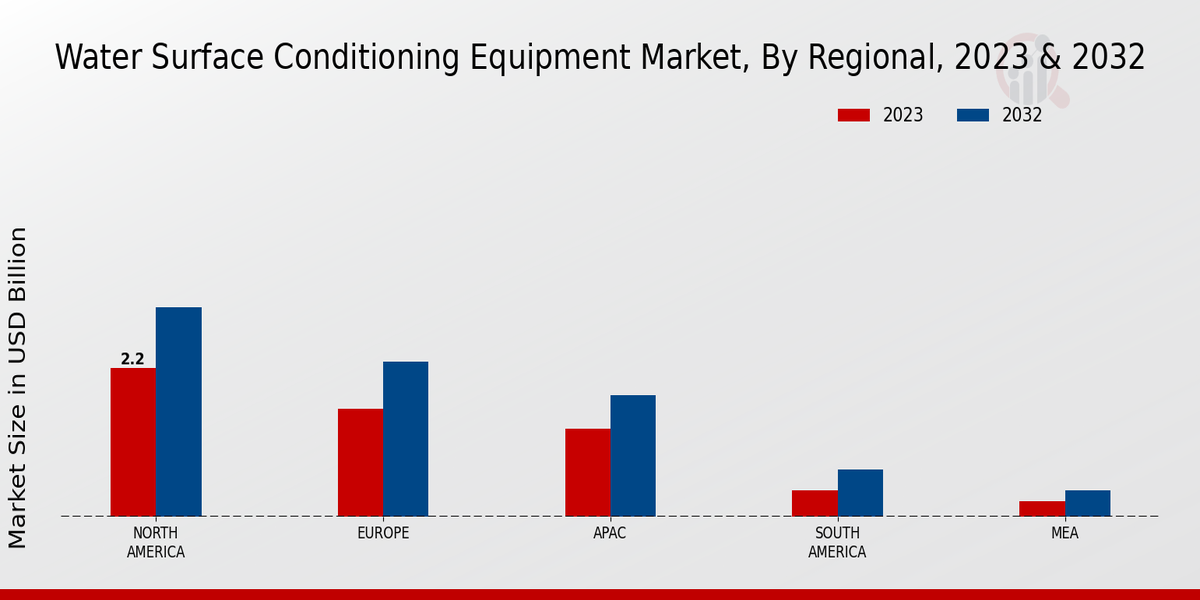Increasing Demand for Clean Water
The Global Water Surface Conditioning Equipment Market Industry experiences heightened demand for clean water, driven by growing population and urbanization. As more individuals require access to potable water, the need for effective water treatment solutions intensifies. For instance, regions facing water scarcity are increasingly investing in surface conditioning technologies to enhance water quality. This trend is expected to contribute to the market's growth, with projections indicating a market value of 6.21 USD Billion in 2024. The focus on sustainable water management practices further propels the adoption of advanced conditioning equipment, ensuring that water sources remain viable for future generations.
Chart Representation of Market Growth Trends
The Global Water Surface Conditioning Equipment Market Industry exhibits notable growth trends, as illustrated in the accompanying charts. The projected market value is expected to rise from 6.21 USD Billion in 2024 to 9.64 USD Billion by 2035, reflecting a steady increase in demand for water conditioning solutions. The charts depict the anticipated CAGR of 4.08% from 2025 to 2035, highlighting the sustained interest in advanced water treatment technologies. These visual representations provide insights into market dynamics, showcasing the factors driving growth and the potential for future investments in the sector.
Technological Advancements in Water Treatment
The Global Water Surface Conditioning Equipment Market Industry benefits from continuous technological advancements in water treatment processes. Innovations such as membrane filtration, advanced oxidation processes, and automated monitoring systems enhance the efficiency and effectiveness of water conditioning. These technologies not only improve water quality but also reduce operational costs for treatment facilities. As a result, municipalities and industries are increasingly adopting these advanced solutions. The market is projected to grow at a CAGR of 4.08% from 2025 to 2035, reaching an estimated value of 9.64 USD Billion by 2035, indicating a robust shift towards modernized water treatment methodologies.
Regulatory Support for Water Quality Standards
The Global Water Surface Conditioning Equipment Market Industry is significantly influenced by stringent regulatory frameworks aimed at maintaining water quality standards. Governments worldwide are implementing regulations that mandate the treatment of surface water to ensure safety for public consumption. This regulatory push encourages investments in water conditioning technologies, as compliance becomes essential for municipalities and industries. For example, the introduction of new guidelines in various countries has led to increased funding for water treatment projects. Consequently, this trend is expected to drive market growth, as stakeholders seek to meet regulatory requirements while improving water quality.
Growing Awareness of Environmental Sustainability
The Global Water Surface Conditioning Equipment Market Industry is witnessing a surge in awareness regarding environmental sustainability. As communities and industries recognize the importance of preserving water resources, there is a growing emphasis on sustainable water management practices. This awareness drives the adoption of water conditioning equipment that minimizes environmental impact, such as energy-efficient systems and those utilizing renewable energy sources. Furthermore, organizations are increasingly seeking certifications that demonstrate their commitment to sustainability, further propelling the demand for advanced conditioning technologies. This trend is likely to shape the market landscape, fostering innovation and investment in eco-friendly solutions.

























Leave a Comment